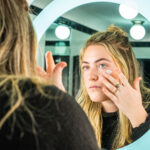Vogue Philippines Makes History by Featuring 106-Year-Old Apo Whang-Od on Its April Cover
Vogue Philippines has made history by featuring the world-renowned tattoo artist, Apo Whang-Od, on the cover of its April issue. This is the first time a person of Whang-Od’s age has ever been featured on the front page of Vogue, which is considered as the world’s pre-eminent fashion magazine. Her tribal tattoos have made her an icon, and her unique 1,000-year-old technique has been passed down from generation to generation, making her the last “mambabatok” in the Philippines.
Who Is Apo Whang-Od?
Maria Oggay, or better known as Apo Whang-Od, comes from the But-but tribe in Kalinga, a province in the Philippines’ far north. At just 16 years old, Whang-Od became a “mambabatok” after receiving instruction from her father. In those days, she would ink only the fiercest warriors and the fairest women of her tribe. The tattoos were a status symbol. Men could only have a tattoo if they had killed someone.
Whang-Od’s unique technique dates back 1,000 years and involves using a 30cm-long bamboo stick and a thorn from a pomelo or lime tree dipped in charcoal soot and water. It describes the technique she uses when putting ink on skin, called “mambabatok” which means “one who pounces.” Whang-Od’s tribal tattoos are not as intricate or detailed by the standards of today’s inkers, but it is what she represents that draws people to her.
Her late-age stardom began in 2007 when anthropologist Lark Krutak came across Whang-Od and filmed the Philippine segment of his Discovery Channel series Tattoo Hunter. Since then, thousands of tattoo enthusiasts, many of them from around the world, have made a pilgrimage to her remote village of Buscalan in Kalinga, which is a 12-hour journey from Manila, including a 1km hike through a narrow trail.
Despite her age, Whang-Od still tattoos anyone who makes the journey to her village. She rewards visitors with a tattoo of the “tatak (stamp of) Buscalan” for as long as her eyes can see. But because of her age, Whang-Od can no longer ink the intricate patterns she used to imprint on the skin of the warriors of her tribe. Those who insist on having her tattoo them would have to be happy with just three dots.
However, Whang-Od is passing on everything she knows, including the ancient chants that go with the tattooing process, to her grandnieces, Ms Grace Palicas, 26, and Ms Elyang Wigan, 23.
Why Did Vogue Philippines Choose Whang-Od?
Vogue Philippines editor-in-chief Bea Valdes explained that the magazine chose Whang-Od to represent the ideals of what is beautiful about Filipino culture. She believes that the concept of beauty needs to evolve and become more diverse and inclusive, including faces and forms which represent the country’s culture. Apo’s age and status as a legend represent that diversity, making her an ideal candidate for the cover.
Final Thoughts
Apo Whang-Od’s story has been a source of inspiration for many. Her unique techniques in tattooing and status as the last “mambabatok” make her a living legend. Her work represents a symbol of bravery, beauty, and fertility in Filipino culture. Vogue Philippines’ decision to make her the first person of her age to grace its cover has been well-received, as it celebrates the beauty of Filipino culture and diversity in the fashion industry.











